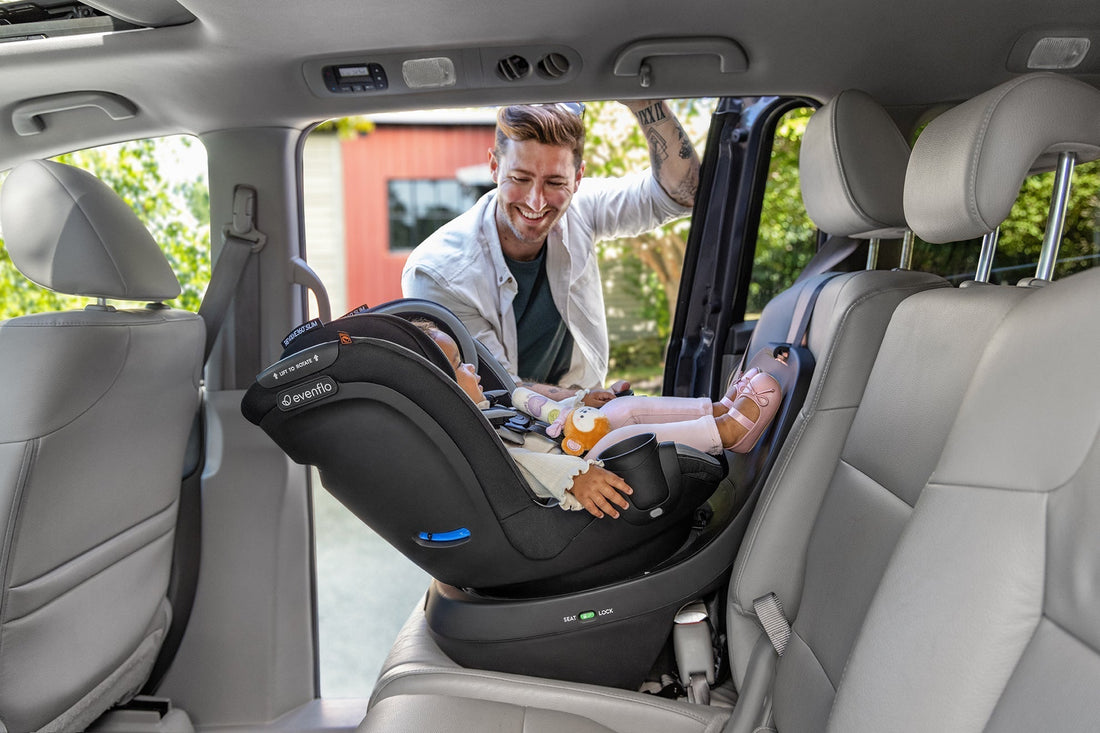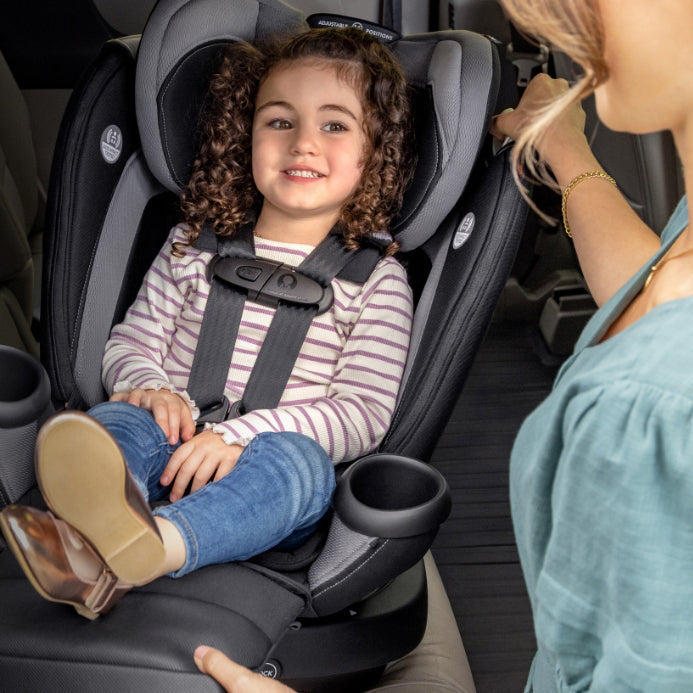
Choosing the Right Car Seat for Your Child’s Size
As a parent, one of the most complicated decisions you can make is choosing the right car seat for your child. We know — there are so many different options on the market, each with its own bells and whistles. It can be daunting to make sure you're investing in the best option for your kiddo’s safety while also getting the features that will make your life more convenient. We're here to help inform you on the different types of car seats out there, and why car seat height and weight limits are some of the most important factors in deciding the right fit.
Car seat weight limits are REQUIRED, and you can find the minimum and maximum height and weight limits by reviewing the labels and instructions provided with your car seat. Another thing to note is that while these limits are one of the most important factors to consider when choosing a car seat, it isn't the only factor. Child age, maturity and fit limitations also play a large role in ensuring your child's safety, depending on which seat they use.
Rear-Facing Only Infant Car Seats
Your new baby must use a rear-facing car seat from birth. Infant car seats are always rear- facing with a harness to provide the appropriate support for smaller kiddos. Typically, rear- facing infant car seats have a minimum weight limit of 4 lb and a maximum weight limit of anywhere between 22 - 35 lb. A rear-facing car seat provides protection for the child’s head, neck and spine, so their height also plays an integral part in having the right fit. The height limits vary with the different weight ratings. In the event of a crash, the child moves with the car seat, and the shell of the car seat absorbs much of the crash force. Babies have disproportionately large heads that they are unable to support themselves. Their muscular/skeletal system is not yet fully developed, and therefore they need additional positioning support. A rear-facing infant car seat is designed to keep them in a reclined position so that they're supported in the unfortunate event of a car crash.
It’s not uncommon for some babies to be ready to go home before they even reach 4 lb — some car seats have been designed to accommodate infants as small as 3lbs! To help meet the needs of families with very small infants, the Evenflo® Revolve180 LiteMax NXT™ Rotating Infant Car Seat with SensorySoothe Technology may be used with an infant weighing as little as 3lb. Please check our FAQs for guidelines when using the Evenflo LiteMax Infant Car Seat if your baby weighs less than 4 lb. The Evenflo® Shyft™ DualRide™ Infant Car Seat Stroller Combo is another great option for smaller infants, as it can be used starting at 3 lb as stated on product label and instructions.
Convertible/All-in-One Car Seats
Convertible car seats are another option for newborns, and a great option for older kids, too. They are designed to adapt and keep pace with your child’s growth spurts. For this reason, they support rear-facing with a harness, forward-facing with a harness and, in the case of the all-in- one car seat, they even offer a booster seat option as well. Most convertible or all-in-one car seats can be used from birth with a minimum weight limit of 4 – 5 lb. The American Academy of Pediatrics recommends that young children remain rear-facing as long as possible, until they have outgrown the height or weight limits of their rear-facing car seat. At Evenflo, we require children to be at least 2 years old before they turn forward-facing. Convertible car seats are typically larger than infant seats and have much higher weight and height requirements as a result. In rear-facing mode, many convertibles max at 40 lb, but there are a growing number of products that offer extended rear-facing up to 50 lb. The Evenflo® Revolve360™ Slim Convertible and the Evenflo® Revolve360™ Extend All-in-One car seats, both offer rear-facing up to 50 lb. In forward-facing mode, convertibles may have an upper weight limit between 40 – 65 lb. Your kiddo’s height plays a major part as well. The harness should be positioned at or above their shoulder, so keep an eye out as they get older. As you near the upper harness height, you should start to think about moving to the next stage.
Harness Boosters
Harness boosters offer both forward-facing with a harness and a booster seat option. Because rear-facing is not included with these car seats, they require higher minimum weight limits. As stated, Evenflo requires children to be a minimum of 2 years old and 22 lb. to be forward-facing. Combination car seats have a maximum weight limit of anywhere between 40 - 65 lb. The Evenflo® Maestro™ Sport can accommodate children between 22 – 110 lb. We strongly suggest you check the product labels and instructions for the height and weight limits for your product.
Booster Seats
The next stage is the booster seat. Booster seats raise a child to the ideal height for proper vehicle seat belt usage and placement. A child in a booster seat will always face forward and will be using the vehicle's provided seat belt. Many booster seats have a minimum weight limit of 40 lb, a minimum height requirement of 44 inches and/or a minimum age limit of at least 4 years old.
The most important factor in deciding if your child is ready for a booster seat, however, is their overall development. Evenflo and other safety experts recommend that children use their forward-facing seat with a harness and tether until they reach the maximum height and weight of their convertible or harness seat before they move to a booster. They must be able to sit in place in the booster seat with the vehicle seat belt buckled and not move around or unbuckle themselves while the car is in motion. Booster seats typically have a maximum weight limit of between 100 - 120 lb. Children should stay in their booster seats until they reach the proper height to fit an adult seat belt.
Transitioning to the Vehicle Seat Belt
When you think it’s time to move your child out of their booster seat and into a vehicle seat, there are a few things to keep in mind. At this point your child will be around 57 in. tall; however, it’s important to note that both kiddos and vehicles come in a wide variety of shapes and sizes. Your child must fit properly in each vehicle that they will be seated in moving forward. It’s possible that they may be able to ride in one vehicle without their booster seat but may still need to use it in a different type of vehicle. To evaluate that fit, check that the vehicle seat shoulder belt lays naturally across their shoulder and does not ride up on their neck. Additionally, check that the lap belt rides low across their hips. Their knees should bend naturally over the front of the vehicle seat and their feet should rest flat on the floor of the vehicle. If their legs are not long enough, they will be uncomfortable — this can cause them to slouch and have improper belt fit which could potentially increase the risk of injury in a crash. This is a big milestone to celebrate with your kiddo while also keeping safety top of mind.
At Evenflo, we take pride in ensuring that your little ones are safe and secure through every stage of growth. We have options for your littlest babes all the way up to your big kiddos. If you have any questions regarding car seats, weight and height limits or more, please reach out to our ParentLink Resource Center for real time chat support or free live video installation service. Look for ParentLink® at Evenflo.com.
